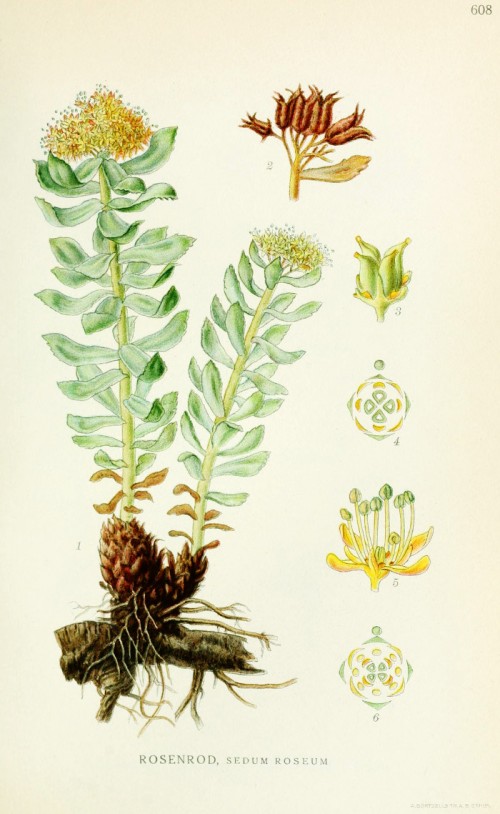Rhodiola rosea L. - syn. Sedum rhodiola DC.; Sedum rosea (L.) Scop. - Crassulaceae - roseroot, golden root,rosewort, Rosenwurz
Deciduous, dioecious perennial, up to 30cm high, native to the northern hemisphere on moisty, rocky ledges and talus of coastal cliffs in the north and of north-facing cliffs; leaves ovate to obovate or oblong; flower petals pale yellow to greenish yellow, sometimes red at tips;
„ R. T. Clausen (1975) noted significant differences among wild populations of Rhodiola rosea [as Sedum rosea] but found that most lost significance when the plants were grown together at Ithaca. He found that staminate plants outnumber pistillate by about 1.2-1.9 to 1 and that an occasional plant has both staminate and pistillate flowers in the same cyme. From meiosis in staminate plants A. Levan (1933) reported one bivalent as slightly heteromorphic and possibly a sex-chromosome pair of the XY type, but C. H. Uhl (1952) noted no heteromorphic bivalents. Roseroot has a long history as a medicinal plant; Clausen summarized what was known of its chemistry and its uses. The name „roseroot“ is from the roselike odor of the dried rootstock.“
http://www.efloras.org/florataxon.aspx?flora_id=1&taxon_id=200009865
„The first time that R. rosea is described was from Dioscorides in De Materia Medica.“ http://de.wikipedia.org/wiki/Rhodiola_rosea
„Rhodiola fluid extract was accepted in the former USSR as a ‘Temporary Pharmacopoeial Article’ which allowed the large-scale industrial production of a liquid extract (DER 1:1, extraction solvent ethanol 40%)…
The traditional use as an adaptogen‘ for temporary relief of symptoms of stress such as fatigue and sensation of weakness is appropriate for traditional herbal medicinal products.“
http://www.ema.europa.eu/docs/en_GB/document_library/Herbal_-_HMPC_assessment_report/2012/05/WC500127861.pdf
„Terpenes and aroma volatiles from rhizomes of Rhodiola rosea L. from Norway have been isolated by both steam distillation and headspace solid-phase micro-extraction coupled with gas chromatography and mass spectrometry analysis. The dried rhizomes contained 0.05% essential oil with the main chemical classes: monoterpene hydrocarbons (25.40%), monoterpene alcohols (23.61%) and straight chain aliphatic alcohols (37.54%). n-Decanol (30.38%), geraniol (12.49%) and 1,4-p-menthadien-7-ol (5.10%) were the most abundant volatiles detected in the essential oil, and a total of 86 compounds were identified in both the SD and HS-SPME samples. Geraniol was identified as the most important rose-like odour compound besides geranyl formate, geranyl acetate, benzyl alcohol and phenylethyl alcohol. Floral notes such as linalool and its oxides, nonanal, decanal, nerol and cinnamyl alcohol highlight the flowery scent of rose root rhizomes.“
[Volatiles from rhizomes of Rhodiola rosea L., Rohloff, J., Phytochemistry, 59(6), 2002, 655-661]
Geraniol is also main component of the essential oils from rhizomes of two Tibetan Rhodiola species, Rhodiola fastigata (45.3%) and Rhodiola crenulata (53.3%). „Many Rhodiola species such as R. rosea and R. crenulata have been used as traditional medicines for the treatment of long-term illness and weakness due to infection in Tibet and other regions for over 1000 years.“
[Chemical composition of the essential oils of two Rhodiola species from Tibet., Lei, Y., Nan, P., Tsering, T., Bai, Z., Zhong, Y., Zeitschrift für Naturforschung C, 58(3-4), 2003, 161-164] http://znaturforsch.com/ac/v58c/s58c0161.pdf
„Due to contradictory results in the literature it was decided to examine the neurophysiological effect of Rhodiola rosea extract on surrogate parameters of cognitive and emotional brain processing in 20 volunteers. Spectral signatures of regional electric brain activity were recorded under control of an Eye-Tracking device, by means of which different challenges were presented… In summary, the extract from Rhodiola rosea modulated cognitive and emotional surrogate parameters indicating improvement of mental processing in a stimulatory and activating sense… intake of Rhodiola rosea extract containing capsules can be regarded as a safe booster of mental activity during cognitive and emotional challenges. It should be mentioned that also other authors already reported on improvement of cognitive performance after repetitive intake of Rhodiola extract …“
[Neurophysiological effects of Rhodiola rosea extract containing capsules (A double-blind, randomised, placebo-controlled study). Dimpfel, W. International Journal of Nutrition and Food Sciences, Vol.3(3), 2014, 157-165] http://article.sciencepublishinggroup.com/pdf/10.11648.j.ijnfs.20140303.14.pdf

Lindman,C.A.M., Bilder ur Nordens Flora, vol.3 t.608 (1922-1926)
http://plantgenera.org/species.php?id_species=929940
Rhodiola rosea
© Rolf Marschner (2017),
www.botanische-spaziergänge.at
